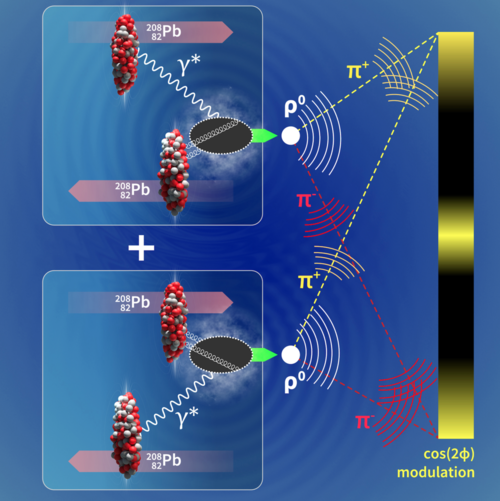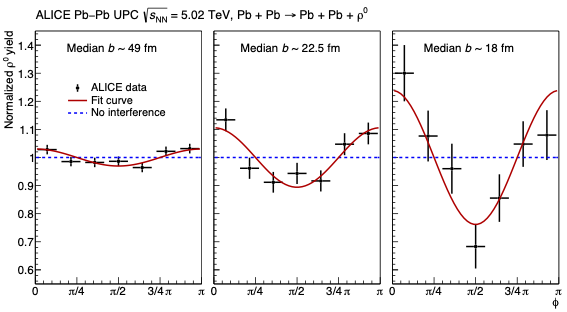
Using collisions between lead nuclei at the LHC, the ALICE collaboration has measured an interference pattern akin to that of the famous double-slit experiment!
CERN News: ALICE does the double-slit
In the famous double-slit experiment, an interference pattern of dark and bright bands emerges when a beam of light hits two narrow slits. The same effect has been seen with particles such as electrons and protons, demonstrating the wave nature of propagating particles in quantum mechanics. Typically, experiments of this type produce interference patterns at the nanometre scale. In a recent study, the ALICE collaboration has measured an interference pattern that may be considered as an analogous experiment at the femtometer scale using ultra-peripheral collisions between lead nuclei at the Large Hadron Collider (LHC); a femtometre (fm) is a quadrillionth of a metre.
In ultra-peripheral collisions between two heavy nuclei, the nuclei pass by close to each other without colliding. Here, the perpendicular distance between the two nuclei – the impact parameter – is larger than the sum of their radii. One nucleus emits a photon that converts into a virtual pair composed of a quark and its antimatter partner. This pair interacts strongly with the other nucleus, resulting in the emission of a type of particle known as a vector meson and the exchange of two gluons (see figure above). Such vector meson photoproduction is a well-established tool to probe the internal structure of the colliding nuclei.
In vector meson photoproduction involving symmetric systems, such as two lead nuclei, it remains indistinguishable which of the nuclei emits the photon and which emits the two gluons. This gives rise to the interference of both possibilities. Moreover, due to the short-range nature of the strong force between the virtual quark-antiquark pair and the nucleus, the vector meson production happens within or close to one of the two nuclei (see figure above). The resulting amplitudes of vector mesons produced from either of the two nuclei interfere. This is akin to the interference of a double-slit interferometer, where the impact parameter takes the role of the distance between the slits.
In the photoproduction of the electrically neutral rho vector meson (ρ0), the subject of the ALICE collaboration’s recent study, the interference leads to a cos(2φ) modulation of the ρ0 yield, where φ is the angle between the two vectors formed by the sum and difference of the transverse momenta of the two oppositely charged pions into which the ρ0 decays. The strength of the modulation is expected to increase as the impact parameter decreases.

In the photoproduction of ρ0 mesons in ultra-peripheral collisions between two lead nuclei, the interference between the two possibilities shown in this illustration leads to a cos(2φ) modulation of the ρ0 yield (figure below), where φ is the angle between the two vectors formed by the sum and difference of the transverse momenta of the two oppositely charged pions (p+ and p-) into which the ρ0 decays. (Image: CERN)
In vector meson photoproduction involving symmetric systems, such as two lead nuclei, it remains indistinguishable which of the nuclei emits the photon and which emits the two gluons. This gives rise to the interference of both possibilities. Moreover, due to the short-range nature of the strong force between the virtual quark-antiquark pair and the nucleus, the vector meson production happens within or close to one of the two nuclei (see figure above). The resulting amplitudes of vector mesons produced from either of the two nuclei interfere. This is akin to the interference of a double-slit interferometer, where the impact parameter takes the role of the distance between the slits.
In the photoproduction of the electrically neutral rho vector meson (ρ0), the subject of the ALICE collaboration’s recent study, the interference leads to a cos(2φ) modulation of the ρ0 yield, where φ is the angle between the two vectors formed by the sum and difference of the transverse momenta of the two oppositely charged pions into which the ρ0decays. The strength of the modulation is expected to increase as the impact parameter decreases.
Using a dataset of 57 thousand ρ0 from lead-lead collisions that took place at an energy of 5.02 teraelectronvolts per pair of nucleons (protons and neutrons) during Run 2 of the LHC, the ALICE team measured the cos(2φ) modulation of the ρ0 yield for different ranges of impact parameter. The impact parameter ranges were selected by detecting the neutrons in the beam direction (measured in the Zero Degree Calorimeters) emitted in electromagnetic processes that accompany the ρ0 photoproduction. The measurements showed that the strength of the modulation has a strong dependence on the impact parameter (see figure below).
Theoretical calculations which describe the measurement, interpret this as the result of a quantum interference effect. Since the ρ0 production occurs close to the two well-separated nuclei, and because of its much shorter lifetime, the ρ0s decay quite rapidly compared to the spatial separation of the two nuclei. This is similar to a two-source interferometer, where the wavefunctions of the ρ0 decay products (p+ and p-) interfere. The p+ and p- may then form a quantum-mechanically entangled state to produce the observed effect without which the two p+ (or p-) wavefunctions would have a random phase and no interference would occur.
In the next runs of the LHC, Run 3 and Run 4, ALICE is expected to collect more than 15 million ρ0 from lead-lead collisions. This enhanced dataset will enable a more detailed analysis of the quantum interference effect.

Modulation of the ρ0 meson yield for different median values of the impact parameter (b). (Image: ALICE)
